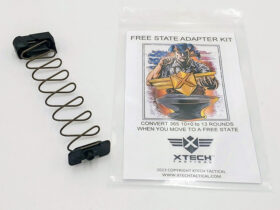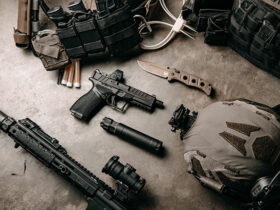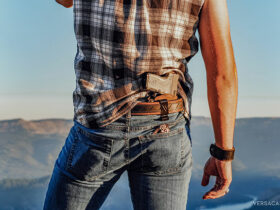Recently, two of the high-end pistols I tested sported fiber-optic front sights. So have a number of relatively inexpensive handguns and a lever-action .22 caliber rifle. In fact, fiber-optics are so prevalent, they demand a hard look at their capability.
At one time, fiber-optics were add-on features, and they are still available as aftermarket accessories. Some folks prefer night sights. Target shooters seem to prefer all-black sights. But experienced shooters that understand that sights must be flexible in many lighting conditions, at different ranges and against different targets, often prefer fiber-optic sights.
I have fired many firearms equipped with fiber-optics and find them excellent choices. The fiber-optic is more properly termed an optical fiber.

Benefits of Fiber-Optics
The fiber-optic is a flexible, colored fiber that transmits light through its total length. The fiber-optic is a mix of plastic and glass. The fiber isn’t very thick at all, but features a sheath surrounding the fiber itself. It is sometimes called a fiber cable.
These fiber-optics do not reflect or bend light, they absorb light, and this results in high visibility. The outer sheath is, however, reflective. So, the fiber-optic results in a core material surrounded by reflective material. Light isn’t transmitted, but rather trapped in the tube and is visible from the shooter’s end.
Fiber-optics are available in a wide range of color. Red and orange are common. Some seem to find green the best choice for their eyes. Fiber-optics are bright and the eye easily picks them up. Accuracy is enhanced, especially when speed is involved. The brighter fiber-optic is much easier to quickly get on target.
While fast shooting is one advantage, fiber-optics are also well-suited to accurate fire at longer ranges. In dim light, they do not glow as tritium does, but in all but total darkness, fiber-optic sights offer a superior aiming point for iron sights, and in bright light are generally superior to night sights.

Price isn’t everything, but fiber-optics are less expensive than night sights. HiViz Shooting Systems fiber-optic sights are a staple among handgunners. A CZ I own has a special attachment. “Wayne’s old gun” features HiViz sights. I have a spare rod kit just in case, but the protected nature of the design makes this unlikely.
What About Durability?
Some will ask if fiber-optics are fragile. On their own, they well may be. This is why Les Baer, among others, supplies spare fiber-optic tubes with their pistols. TruGlo sights are a good design, in that the front post and rear sight protect the fiber-optic from damage, making for a remarkably rugged unit. The sights combine tritium and fiber-optics for superb 24-hour capability.
I have tested these sights in several configurations on all types of handguns with excellent results. They are versatile, affordable, and offer good accuracy potential. It is difficult to choose, all variations seem viable, but I think the TruGlo TFX is well-suited to personal defense. The fiber-optic unit is well-protected.

My variants feature a white circle around the front dot. I like the contrast offered by these sights. The TFO offers the option of using the rear sight to rack or release the slide from slide lock.
It’s All About Accuracy
When it comes to accuracy potential, fiber-optic sights really shine — pun intended. The sights are highly visible in any type of light, making for a good sight picture. Use the standard sight alignment, control the trigger, and you get a hit.
When you choose a front sight, there is some concern a wide front sight will subtend the target — cover so much of the target at long range that accuracy is difficult — but I have done good shooting with fiber-optics.

The Les Baer 572 Hemi comes with a three-inch group guarantee at 50 yards. It also features a fiber-optic front sight. That tells us something about how far fiber-optics have come.
Final Thoughts
If you need something to help with visual acuity or to be all you can be, consider fiber-optic sights, they may be the right choice for your shooting style.
Have you ever tried fiber-optic sights? What type of sights do you prefer on your pistols? Let us know in the Comment section.
Editor’s note: This post was originally published in February of 2021. It has been completely revamped and updated for accuracy and clarity.









Leave a Reply